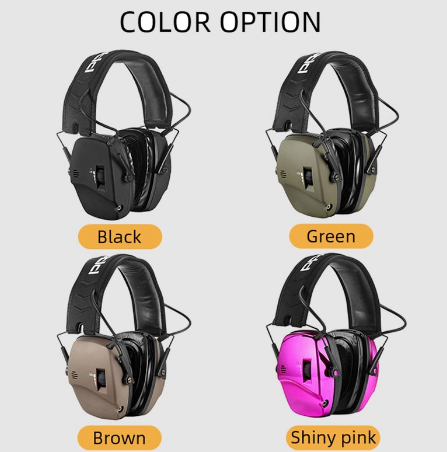Ear Plugs vs Ear Muffs for Shooting
What is Ear Protection in PPE?
Anyone in the vicinity of gunfire needs hearing protection, so ear plugs and/or ear muffs are some of the most essential pieces of safety gear that you can have when you’re going shooting. Shooting ear protection (often called “ear pro”) is necessary for everyone on the range, including shooters and bystanders. This is also true for hunters in the field. Today, many types of hearing protection devices are available on the market that won’t hamper hearing game and maintaining situational awareness.
Any noise over 85 decibels (dB) can cause permanent hearing loss, which can be compounded by other factors like shooting indoors. Guess what? A .22 Long Rifle, one of the smallest calibers used for hunting and recreational shooting, produces at least 140 dB using standard loads. Hearing damage can occur in as little as one shot, and the effects are cumulative over time with repeated noise exposure.
Sound that can be heard by humans is measured in decibels, which start at 0 and go up exponentially with each unit of measurement and are abbreviated as “dB.” As I mentioned, 85 dB is the top threshold of safe noise levels. What’s that in real-world terms?
· A busy city street or lawnmower is about 85dB
· A car horn is roughly 110dB
· A chainsaw buzzes around 120dB
· Rock bands are notorious for loud concerts, averaging 115dB
- The Beatles hit 130dB in 1965, and that’s the threshold of pain for noise exposure.
- The confirmed loudest concert so far was 143.2dB in 2008 by Sleazy Joe. Scientifically speaking, that’s a whole lot of shakin’ going on.
Again, even a small-caliber .22LR is around 140dB, so it’s always important to have ear pro when you’re around gunfire. NRR is the Noise Reduction Rating of hearing protection, normally ranging from 21 to 33. For shooting, you’re going to want a bare minimum of 25, but the more the better. Remember, since dB’s increase exponentially, so does the NRR. A difference of even one decibel or NRR can be the difference between safety and hearing loss. The best shooting ear protection is what you’ll use consistently and without hesitation, so it should be comfortable and suit your needs. Here’s an overview of the most common types of hearing protection devices with some pros and cons.
EM036 Electronic Shooting Hearing Protector
Ear Plugs: Pros and Cons
Earplugs are pretty self-explanatory. They’re devices placed into the ear canal to block noise. They’re the simplest types of ear protection devices, and usually the least expensive. You’ve probably seen “foamies,” the little brightly colored foam earplugs that come in bulk packs. They’re designed to be twisted and placed into the ear, where they expand to block the ear canal. Some come with a small tether cord between them to make them easily accessible when not in use.
Pros:
· Very economical, usually less than a dollar a pair
· Small and easily tucked into a container about half the size of a ping pong ball
· More comfortable for longer periods of time, particularly in the heat
· Mould to the inner ear, making them a nearly universal fit when used properly
· Do not interfere with wearing glasses, hats, helmets, etc.
· Can be worn under ear muffs to “double up” protection
Cons:
· Short lifespan, get dirty fast
· Some users may have difficulty inserting and removing them
· Improperly fitted, NRR is reduced
· Any dust or dirt accumulated during handling will be introduced to the ear, not ideal for setting down or pocket carry
· May cause irritation in the ear canal
To increase the pros and reduce the cons, there are more advanced earplugs that are more durable, washable, and fitted. These tend to cost more but are well worth it if you’re a frequent shooter. Some are rubberized, and others will allow normal ambient sound to transfer through but have valves that close automatically when noise levels increase. There are even models that are Bluetooth compatible or corded that allow you to listen to music while providing hearing protection from outside noises. However, if you’ve got Sleazy Joe cranked up to 11, it may be a wash. Invest a little money and buy a few different kinds to find the best earplugs for you.
Ear Muffs: Pros and Cons
Again, pretty self-explanatory. These are the same form as the earmuffs worn in the winter but are designed to provide hearing protection. They provide a better NRR because they enclose the entire ear, and the spring tension of the connecting headband holds them tightly to the head. Electronic ear muffs add to that, using technology that automatically detects when noise reaches about 85dB and switches off the mic. They’re useful for maintaining situational awareness and being able to hear range commands or wild game. Also available with Bluetooth or a headset jack, if that’s what you’re looking for.
Pros:
· Superior NRR protection
· Can be set down without worrying about dust and debris
· Stay firmly in place
· Not easy to lose
· Can be worn even if ears are irritated or you have an ear infection
· Fits most head sizes
· Can be worn over earplugs to “double up” protection
Cons:
· Can be uncomfortable in hot weather
· Can lose NRR if ear bows of glasses are between the muffs and the head
· Can interfere with helmets, hats, etc.
· Increased cost
· Bulky, carrying and storage require more space
355
0
0


Comments
All Comments (0)